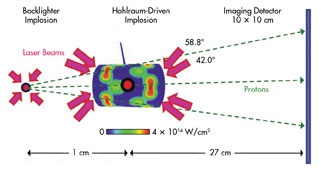Harnessing fusion energy requires achieving the milestone of fusion ignition in the laboratory. At
Lawrence Livermore National Laboratory’s National Ignition Facility in Livermore,
Calif., researchers are attempting indirect drive inertial fusion, involving a tiny
capsule of heavy hydrogen fuel centered inside a hohlraum cavity.

This schematic shows how imaging an implosion
was done in test. To the left are 15 laser beams that entered each end of the hohlraum.
The proton backlighter was driven by 30 laser beams. As the backlighting protons
passed through the laser-driven hohlraum, the plasma conditions and capsule implosions
were sampled at various times.
Beams from 192 lasers with nearly 2 million joules of ultraviolet
energy in a billionth-of-a-second pulse are directed to the inside walls of the
hohlraum, which is heated, generating x-rays that implode the capsule to ignition
conditions. Fusing atoms at the center of the capsule cause surrounding atoms to
fuse, leading to ignition, a nuclear energy release greater than the laser energy
required for the implosion. To achieve ignition, diagnostic tools are needed to
see what happens inside the imploding capsule.
The capsule, containing deuterium-tritium, must be imploded with
nearly perfectly spherical symmetry. Theoretical designs constrain the level of
symmetry that must be achieved, and researchers are developing a variety of techniques
to measure it. A challenge in achieving ignition is that the reactions take place
inside a fuel capsule with an initial 2-mm diameter that has been compressed to
such a degree that its temperature and pressure become much greater than those at
the center of the sun.
A team led by Richard Petrasso, a scientist at MIT’s Plasma
Science and Fusion Center, developed a fusion backlighting method using charged
particles generated in a secondary implosion to probe the hohlraum and capsule dynamics.
This technique was tested on the Omega Laser System at the Laboratory for Laser
Energetics at the University of Rochester in New York. A capsule filled with deuterium
and helium-3 was imploded, producing large numbers of energetic protons with energies
of 14.7 and 3.0 MeV.
Collaborators from Lawrence Livermore National Laboratory, the
Plasma Science and Fusion Center at MIT, the Laboratory for Laser Energetics and
General Atomics in San Diego observed an asterisklike pattern in the electric fields
within the hohlraum. In the experiment, 30 laser beams with a wavelength of 0.351
μm produced the radiation field in the hohlraum, while another 30 imploded
the deuterium and helium gas-filled capsule used for the radiograph. A nuclear track
detector recorded the proton images, determining the spatial distribution of the
number of protons and their energy. Distribution is affected by the electric and
magnetic fields within the capsule, while energy is determined by the amount of
material they pass through. By taking an image and changing the timing of the proton
sampling (the time when the backlighting protons start to pass through the target),
the time evolution of the hohlraum conditions are probed (making a movie). The pattern
recorded in the image results from the positioning of the incoming laser beams,
but it will require further analysis to fully understand the implications regarding
fusion.